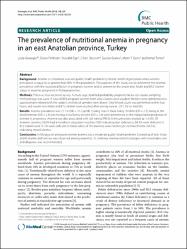| dc.contributor.author | Karaoğlu, Leyla | |
| dc.contributor.author | Pehlivan, Erkan | |
| dc.contributor.author | Eğri, Mücahit | |
| dc.contributor.author | Deprem, Cihan | |
| dc.contributor.author | Güneş, Gülşen | |
| dc.contributor.author | Genç, Metin F. | |
| dc.contributor.author | Temel, İsmail | |
| dc.date.accessioned | 2020-12-19T20:11:39Z | |
| dc.date.available | 2020-12-19T20:11:39Z | |
| dc.date.issued | 2010 | |
| dc.identifier.citation | Karaoglu, L., Pehlivan, E., Egri, M., Deprem, C., Gunes, G., Genc, M. F., & Temel, I. (2010). The prevalence of nutritional anemia in pregnancy in an east Anatolian province, Turkey. BMC public health, 10, 329. https://doi.org/10.1186/1471-2458-10-329 | en_US |
| dc.identifier.issn | 1471-2458 | |
| dc.identifier.uri | https://doi.org/10.1186/1471-2458-10-329 | |
| dc.identifier.uri | https://hdl.handle.net/11436/3765 | |
| dc.description | PubMed: 20537176 | en_US |
| dc.description.abstract | Background. Anemia is considered a severe public health problem by World Health Organization when anemia prevalence is equal to or greater than 40% in the population. The purpose of this study was to determine the anemia prevalence with the associated factors in pregnant women and to determine the serum iron, folate and B12 vitamin status in anaemic pregnants in Malatya province. Methods. This is a cross-sectional survey. A multi-sage stratified probability- proportional-to-size cluster sampling methodology was used. A total of 823 pregnant women from sixty clusters were studied. Women were administered a questionnaire related with the subject and blood samples were drawn. Total blood count was performed within four hours and serum iron, folate and B12 vitamin were studied after storing sera at -20 C for six months. Results. Anemia prevalence was 27.1% (Hb < 11.0 gr/dl). Having four or more living children (OR = 2.2), being at the third trimester (OR = 2.3) and having a low family income (OR = 1.6) were determined as the independent predictors of anemia in pregnancy. Anemia was also associated with soil eating (PICA) in the univariate analysis (p < 0.05). Of anaemic women, 50.0% had a transferrin saturation less than 10% indicating iron deficiency, 34.5% were deficient in B12 vitamin and 71.7% were deficient in folate. Most of the anemias were normocytic-normochromic (56.5%) indicating mixed anemia. Conclusions. In Malatya, for pregnant women anemia was a moderate public health problem. Coexisting of iron, folate and B vitamin deficiencies was observed among anaemics. To continue anemia control strategies with reasonable care and diligence was recommended. © 2010 Karaoglu et al; licensee BioMed Central Ltd. | en_US |
| dc.language.iso | eng | en_US |
| dc.publisher | Springer Link | en_US |
| dc.rights | info:eu-repo/semantics/openAccess | en_US |
| dc.title | The prevalence of nutritional anemia in pregnancy in an east Anatolian province, Turkey | en_US |
| dc.type | article | en_US |
| dc.contributor.department | RTEÜ, Tıp Fakültesi, Dahili Tıp Bilimleri Bölümü | en_US |
| dc.contributor.institutionauthor | Karaoğlu, Leyla | |
| dc.identifier.doi | 10.1186/1471-2458-10-329 | |
| dc.identifier.volume | 10 | en_US |
| dc.relation.journal | BMC Public Health | en_US |
| dc.relation.publicationcategory | Makale - Uluslararası Hakemli Dergi - Kurum Öğretim Elemanı | en_US |


















